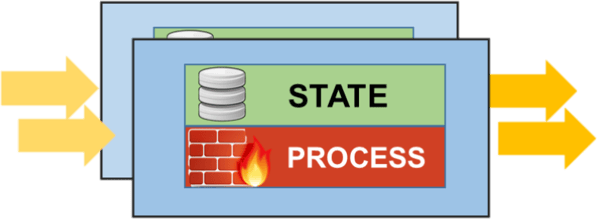Posted by Clayton Schneider ● Jul 17, 2017 5:25:00 PM
State and the Network Challenges It Creates
In the last post, we outlined three clear goals network functions must meet in order to satisfy total network agility:
- Seamless scalability
- Failure resiliency
- Instant deployment
Network vendors have started offering virtual machine versions of their appliances, a step in the right direction. However, these technologies simply mimic the core architecture of physical appliances. Though you no longer have to physically plug in a box, in terms of performance and efficiency the system is still extremely limited.

The true problem lies with “state,” a temporary memory of preceding events or user interactions. It exists in every network function, and its wide dispersement throughout the network creates limitations.
Here, we’ll use a couple of analogies to help describe the problems networks currently face.
Imagine that you are at a restaurant with a bunch of friends, and your waiter has just taken the entire order without writing anything down. Before he can relay that information to the kitchen, he mysteriously vanishes. Ten minutes later, a new waitress comes by and asks if your table is ready to order. This is a huge problem! Time has been wasted, and now you’ve got to start the whole process over again. To top it all off, you’re still really hungry.
Or you could imagine that your workplace has a team of security guards who are constantly rotating. You might walk in and get clearance from one guard, but then on your way out you’re stopped by a different guard. He would have to contact each of the other guards to make sure that just one of them gave you clearance that morning. On a large scale with many employees and many guards, this gets hectic and complicated very quickly!
Of course, the problems of state are much more technical. Take firewalls, for example, which keep track of connections and other information to determine what to allow through the network and what to block. If a firewall fails, we can very easily create a new instance of that firewall. However, the “state” that existed (the previously tracked connections) in the first device has been lost, this creates disruption for the user — and this is just one example. Scaling faces similar problems. Multiple network functions must communicate constantly to ensure that state is synced, creating massive overhead with tens or hundreds of these devices.
Traditional network infrastructure will need a fundamental change in order to combat the problems with state.

